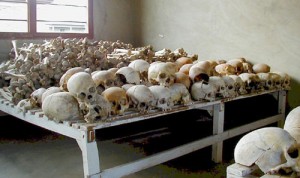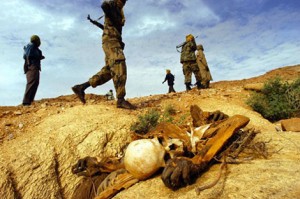Samantha Prior ’14
Professor Robert Brigham – History Department

US Army soldiers coming down a street in Kismayo, Somalia.
http://farm6.staticflickr.com/5177/5414662835_25e5ce0da7_o.jpg
In 2005 the concept that had been coined “Responsibility to Protect” or “R2P” was included in the outcome document from the UN World Summit and was formalized by the Security Council the following year. R2P seeks to reconcile the issues of state sovereignty and the prevention of mass atrocities, which are often seen as at odds with each other. At the core of R2P is the idea of “humanitarian intervention.” The three “pillars” of R2P are as follows:
1. The State carries the primary responsibility for protecting populations from genocide, war crimes, crimes against humanity and ethnic cleansing, and their incitement.
2. The international community has a responsibility to encourage and assist States in fulfilling this responsibility.
3. The international community has a responsibility to use appropriate diplomatic, humanitarian and other means to protect populations from these crimes. If a State is manifestly failing to protect its populations, the international community must be prepared to take collective action to protect populations, in accordance with the Charter of the United Nations.
The concept of R2P is often viewed as born of the series of mass atrocities that occurred throughout the 1990s, including (but not limited to) the crises in Somalia, the Balkans and Rwanda and the way the international community responded to (or did not respond to) them. As can be seen with recent examples such as Libya and Syria, this idea and the debate surrounding it is continually relevant in the world today.

The remains of victims of the Rwandan Genocide
http://upload.wikimedia.org/wikipedia/commons/d/db/Rwandan_Genocide_Murambi_skulls.jpg
The case of the Rwandan Genocide is particularly compelling with regard to the development of these ideas due to the extreme nature of the violence and the astonishing lack of action on the part of important actors such as the United States and the United Nations. The project that I am working on in conjunction with Professor Brigham is researching the attitudes and actions of the Clinton Administration during the development of the genocide in Rwanda for a planned book on the topic.
-

President Clinton
http://www.personal.psu.edu/faculty/t/3/t3b/Tom’smediafolder/media%20SpCom%20597c%20spring%202002/Clinton%20state%20of%20the%20union%201995.jpgThe aim of the research is to get an idea of how Clinton’s policy regarding humanitarian intervention was being formed and reformed, and how that was translated into the policy concerning Rwanda. There is an impressive amount of primary source documents available online through resources such as the NSA, State Department and the Public Papers of the President. The declassification of documents related to Rwanda is ongoing so more information is continually being made available. My primary task is finding and reading these documents to see if they contain pertinent information. Here is an example of a document I might encounter (alone with some of my annotations – in purple): Rwanda – Geneva Convention Violations. In addition to being exposed to a plethora of fascinating documents and information, this project has given me greater awareness and appreciation of what goes into the process of writing such a book, which is akin to many of those that I encounter in the course of my studies.

